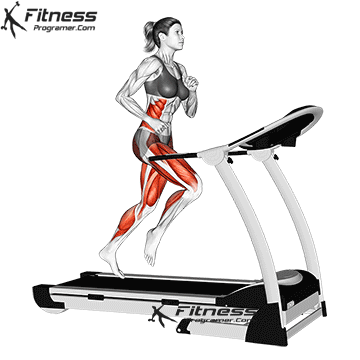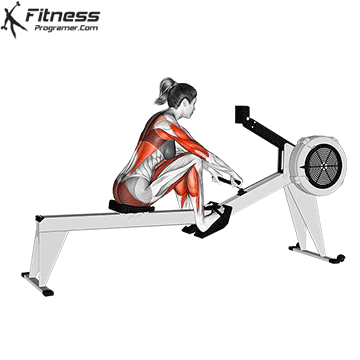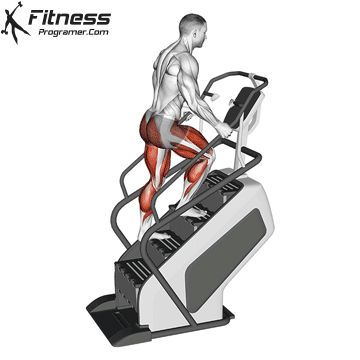The Ultimate Beginner’s Guide to Fitness
Living a healthy lifestyle is all about taking care of your mind and body. Fitness is a crucial part of this equation, and creating a personalized fitness plan is the first step to achieving your health and wellness goals. This guide will walk you through everything you need to know to craft a fitness plan that fits your unique needs and preferences.
What is Fitness?
In essence, fitness is the ability to perform physical activities with ease and endurance. When planning a well-rounded workout routine, it is important to understand the five components of physical fitness and how your training affects them. It encompasses several components, including:
- Cardiovascular endurance: This refers to your body’s ability to deliver oxygen to your muscles during physical activity.
- Muscular strength: This is the ability of your muscles to exert force.
- Muscular endurance: This is the ability of your muscles to sustain repeated movements.
- Flexibility: This is the range of motion in your joints.
- Body composition: This refers to the ratio of muscle mass to fat mass in your body.
FIn short, fitness means being physically healthy and fit. When we go into a little detail, we see that it includes concepts such as muscle strength, muscular endurance, body composition. Of course, it also includes features that are not limited to these. For example, mental health is one of them. A well-rounded fitness plan incorporates exercises that target all of these components to create a holistic approach to improving your overall health and well-being.
WHAT’S THE GOAL OF THE Fitness PLAN?
Many goals such as losing weight, gaining weight, creating a fit body, getting stronger, being durable will help you create your fitness workouts.
- Set a Goal
- Choose exercises suitable for the target
- Choose Your Sets and Reps.
- Plan your workout
Setting SMART Fitness Goals
The foundation of any successful fitness plan is setting clear and achievable goals. SMART goals are specific, measurable, attainable, relevant, and time-bound. Here’s how to apply the SMART criteria to your fitness goals:
- Specific: Instead of a vague goal of “getting in shape,” aim for something more concrete, like “increasing my cardio endurance by running for 30 minutes three times a week.”
- Measurable: Define how you will track your progress. For example, you could use a heart rate monitor to track your cardio endurance or a weight scale to monitor your body composition.
- Attainable: Set goals that are challenging but achievable based on your current fitness level.
- Relevant: Make sure your goals align with your overall health and wellness aspirations.
- Time-bound: Establish a timeframe for achieving your goals. This will help you stay motivated and on track.

How to Create Fitness Plan
The first thing to consider is the goal of the training plan. If you want to lose weight, you must create a calorie deficit. In this case, you will need more cardio exercises and weight training.
If you want to train not for athletic performance but to be healthy and fit, walking, jogging, jumping rope, cycling, swimming, and various home exercises are all effective at keeping you fit. However, if you want to plan training for athletic performance, it is necessary to choose exercises according to the branch you are doing.
For example, if you’re a marathoner, you need strong leg muscles. At the same time, your upper body muscles will remain weak as your leg muscles are constantly working. Targeting upper body and lower body exercises with functional movements in order to strengthen at an optimum level will benefit you in the fitness plan you will create.
Setting your goals makes your exercise choice easier, helps you determine the right number of sets and repetitions, and provides convenience for the fitness plan you will create.
Physical Activity Readiness Questionnaire (PAR-Q)
This physical activity readiness questionnaire (PAR-Q) will help determine if you’re ready to begin an exercise routine or program.
• Has your doctor ever said that you have a heart condition or that you should participate in physical activity only as recommended by a doctor?
• Do you feel pain in your chest during physical activity?
• In the past month, have you had chest pain when you were not doing physical activity?
• Do you lose your balance from dizziness? Do you ever lose consciousness?
• Do you have a bone or joint problem that could be made worse by a change in your physical activity?
• Is your doctor currently prescribing drugs for your blood pressure or a heart condition?
• Do you know of any reason you should not participate in physical activity?
If you answered yes to one or more questions, if you are over 40 years of age and have recently been inactive, or if you are concerned about your health, consult a physician before taking a fitness test or substantially increasing your physical activity. If you answered no to each question, then it’s likely that you can safely begin exercising.
Exercise Selection for Fitness Plan
There’s a vast array of exercises to incorporate into your fitness plan. Here are some of the most common types:
1. Aerobic Exercises
Cardio is also considered aerobic exercise, meaning it demands elevated oxygen flow, which causes you to breathe harder. Aerobic exercises are effective for weight loss, fitness and cardiovascular endurance.
Cardio can be a steady-state, low- to moderate-intensity exercise, or intervals of high intensity. It just needs to tax the large muscle groups strenuously enough and long enough to get you breathing heavily—which means you’re challenging your heart and lungs.
Examples of Aerobic Exercise
Any kind of physical activity that makes your heart rate go up is considered cardio. So, if an exercise gets your heart rate up for a while, it’s cardio exercise. If you want to see more aerobic exercises, select the “Cardio” category in the exercise list.



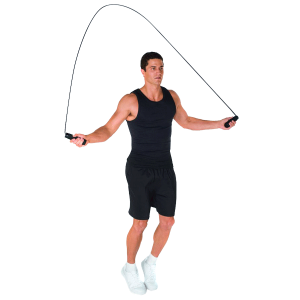
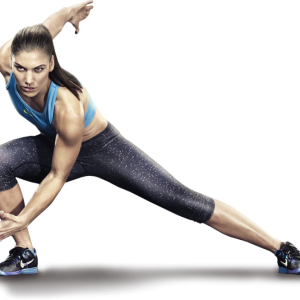
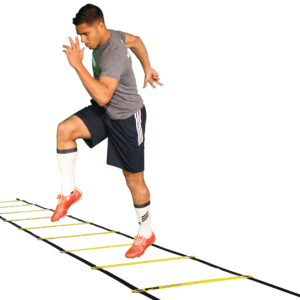
Creating a Cardio Plan
Cardio exercise doesn’t have to take place in a gym. Many activities in our daily lives can provide cardio exercise, like taking the stairs, raking leaves or shoveling snow. Aim for at least 2-3 cardio workouts per week—a 10-15-minute high-intensity workout or an hourlong low-intensity activity.
- According to the Centers for Disease Control, adults should perform 2 hours and 30 minutes per week of moderate-intensity aerobic training or 1 hour and 15 minutes per week of vigorous-intensity or an equivalent mix of both.
- Aerobic workout should be performed for at least 10-20 minutes at a time and spread throughout the week.
- For greater health benefits, 5 hours per week at a moderateintensity level or 2 hours and 30 minutes at a vigorous-intensity level or an equivalent mix of both is recommended.
- The American College of Sports Medicine states that moderate-intensity physical activity between 150-250 minutes per week is effective in preventing weight gain, but will provide only modest weight loss. Physical activity greater than 250 minutes per week is recommended for weight loss and the prevention of weight gain.
Sample: Beginner Cardio Plan
- EXERCISE 1 TREADMILL – 10 Min
- EXERCISE 2 ROWING MACHINE – 5 Min
- EXERCISE 3 ELLIPTICAL MACHINE – 5 Min
- EXERCISE 4 STAIR CLIMBER MACHINE – 5 Min
Sample: High-intensity interval training (HIIT)
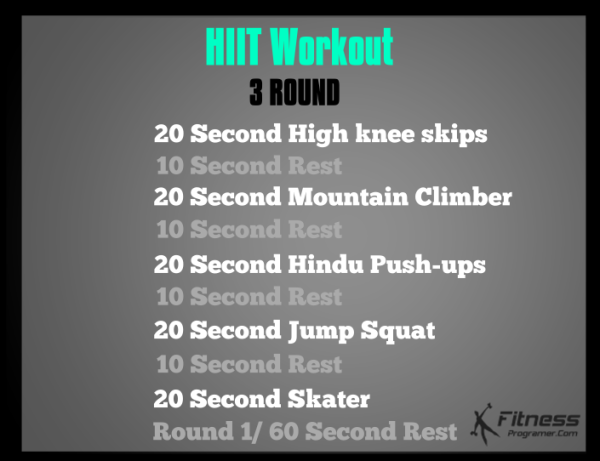
HIIT WORKOUT
- 20 Sec High knee skips
- 10 Sec Rest
- 20 Sec Mountain Climber
- 10 Sec Rest
- 20 Sec Hindu Push-ups
- 10 Sec Rest
- 20 Sec Jump Squat
- 10 Sec Rest
- 20 Sec Skater
- 60 Sec REST
2. Weight Training
Weight training is an organized exercise in which muscles of the body are forced to contract under tension using weights, body weight or resistance bands in order to stimulate growth, power, strength, and endurance. Weight training is also called “resistance training” or “strength training.”
- Muscle strength: The maximal amount of force that can be generated by amuscle or muscle group during a muscular contraction.
- Muscle power: The maximal amount of force that can be developed in agiven time.
- Muscle endurance: refers to the ability of a given muscle or group of muscles to exert force, consistently and repetitively, over a period of time.
- Hypertrophy: The maximal increase in the size of skeletal musclethat can be attained
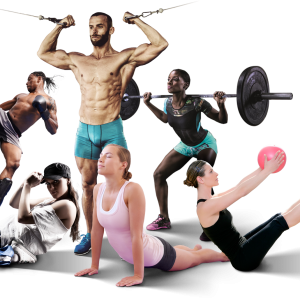




TRAINING VARIABLES THAT AFFECT HYPERTROPHY AND MAX STRENGTH
Several important variables ultimately determine whether a program will lead to muscle growth or increased strength. These terms can be a little confusing, but it’s important to know the differences between them. Five key variables discussed here are:
- intensity
- repetitions
- rest period
- sets
- exercise selection.
| Type | High | Med | Low |
|---|---|---|---|
| Intensity (% of 1RM) | 80–100% | 40–70% | 0–40% |
| Volume (per muscle) | 3+ exercises | 2 exercises | 1 exercises |
| Sets | 4+ sets | 2–3 sets | 1 set |
| Reps | 20+ reps | 8–15 reps | 1–6 reps |
| Frequency | 4+ | 2–3 | 1 |
- Volume refers to the number of muscles worked, exercises, sets, and reps during a single session. For example, if you’re doing a strength exercise, your total volume is the number of sets multiplied by the number of reps in each set. If you do 4 sets of bench press and 10 repetitions during each set, your total volume is 40 repetitions. You can also think of volume as the total work your muscles do in a given period (e.g., 1 week).
- Intensity refers to the weight or load used during an exercise. The amountof resistance used will determine the type of muscular adaptation that will take place. Depending on the resistances used, either maximal strength, power or hypertrophycan be targeted.
- Rest period: The duration of rest periods used between sets andexercises affects the type of physiological adaptation that takes place at the end oftraining and should be directed by the objective of the training program.
- Frequency refers to how many workout sessions are performed per week. On average, it takes two days for muscles to recover. A training frequency of two or three times per week has greater effect on muscle size than once per week, whereas training volume has more effect on muscle strength than training frequency.
For example, this is how the increase in intensity, frequency and volume in a workout is seen. (Progressive Overload)
| Strength Training | Cardio Training | |
| Intensity | Increase the number of weight for a given load | Increase pace for a given time or distance |
| Volume | Increase the number of reps | Increase length of workout or distance |
| Frequency | Increase the # of workout days | Increase the # of workout days |
| Type | Perform a different exercise for the same muscle group | Perform a different type of exercise, ex. running to cycling |
Beginners need less volume and intensity in their training program than advanced lifters, but generally need more frequency.
Weight Training Exercise Selection
- A compound exercises is a multi-joint movements that works several muscles at one time. Some examples squat, bench press and deadlift. If you’re a beginner, compound exercises (pull-up, push-up, bodyweight squat) help you build your foundation quicker by giving you more for the time and effort you put in.
- Isolation exercises work one muscle at a time. Some examples might be the Bicep curl, tricep pushdown, dumbbell fly, leg curl and extension. If your goal is to develop a single muscle group, adding isolation exercises is helpful.
Whichever form of exerxise is chosen, multiple-joint, large muscle group exercises should be performed before single-joint, smaller group exercises.
To Workout for Muscle Growth (Hypertrophy)
The type of weight training done by bodybuilders is meant to create microscopic tears in the muscle, forcing the body to repair the muscles and expand the storage capacity. The repairs cause the muscles to grow, a process known as hypertrophy. Combining a suitable workout with a high-protein diet and plenty of rest in off-times will ensure effective results.
In general, most bodybuilding programs, as well as many general fitness workout, work within rep ranges of 6-12 with 60-85% of one rep max. In other words, bodybuilding plans will use lower weights, or lower average intensity, for higher rep ranges. Plans designed to build upper-end strength, however, will prescribe higher average intensities (80%-100% on average) at lower rep ranges.
Are you looking to grow your shoulders, legs, or biceps?
Recommended intensity, frequency, set and rep range for hypertrophy.
- Intensity: 60-85% of 1 rep max
- Set and reps: 3-6 sets per exercise / 6-12 repetitions per set
- Between reps: 30-90 seconds rest
- Frequency: 2 to 3 days per week of training has been effective in increasing musclehypertrophy. Higher frequencies may be used to fully maximize hypertrophy.
If you are doing weight training for the first time, the volume and intensity are kept low, the priority is to aim to do the exercises right.
Sample: Split Workout For Beginner
These exercises are ideal for those starting weight training for the first time.
Before starting the training, warm-up exercises should be done for 10-15 minutes. (arm circles, treadmill, bike)
Perform this workout with low weights 2-3 times a week for 2 weeks, then change your program by choosing free weights. (for example, replace the chest press machine exercise with the bench press)
Starting a real workout may take an average of 1-2, maybe 3 months, depending on your physical capacity, until this time, focus on doing the movements in the right form and increase the weights as you get stronger.
For example: Monday workout A, Tuesday REST, Wednesday workout B, Thursday REST..
| 1 day workout A: Chest / Shoulder / Arm | Sets x Reps | Intensity | Recovery |
| Lying Chest Press Machine | 2 x 8 | Very low weight | 60 Sec |
| Pec Deck Fly | 2 x 8 | Very low weight | 60 Sec |
| Incline Dumbbell Press | 2 x 8 | Very low weight | 60 Sec |
| Dumbbell Shoulder Press | 2 x 8 | Very low weight | 60 Sec |
| Dumbbell Lateral Raise | 2 x 8 | Very low weight | 60 Sec |
| Rear Delt Machine Fly | 2 x 8 | Very low weight | 60 Sec |
| Dumbbell Curl | 3 x 8 | Very low weight | 60 Sec |
| Triceps Push Down | 3 x 8 | Very low weight | 60 Sec |
| 2 day workout B: Back / Leg / Ab | Sets x Reps | Intensity | Recovery |
| Lat Pulldown | 2 x 8 | Very low weight | 60 Sec |
| Seated Cable Row | 2 x 8 | Very low weight | 60 Sec |
| Dumbbell Row | 2 x 8 | Very low weight | 60 Sec |
| Bodyweight Squat | 3 x 10 | Bodyweight | 45 Sec |
| Leg Extension | 3 x 8 | Very low weight | 60 Sec |
| Leg Curl | 3 x 8 | Very low weight | 60 Sec |
| Standing Calf Raise | 3 x 10 | Bodyweight | 45 Sec |
| Lying Knee Raise | 3 x 12 | Bodyweight | 45 Sec |
Sample: Full Body Hypertrophy Workout
Unlike split training, this full body workout is designed to work all body muscles in one day. This training, which is not suitable for beginners, can be applied at least 2 times a week for intermediate and advanced athletes.
| Exercise | Sets x Reps | Intensity | Recovery |
| Barbell Squat | 4 x 12 | % 70-75 | 60 – 90 Sec |
| Bench Press | 4 x 12 | % 70-75 | 60 – 90 Sec |
| Bent Over Row | 4 x 12 | % 70-75 | 60 – 90 Sec |
| Overhead Press | 4 x 12 | % 70-75 | 60 – 90 Sec |
| Dumbbell Curl | 4 x 12 | % 70-80 | 60 – 90 Sec |
| Push Down | 4 x 12 | % 70-80 | 60 – 90 Sec |
| Wrist Roller | 4 x 12 | % 25 | 60 – 90 Sec |
| Bicycle Crunch | 3 x 20 | Bodyweight | 30 – 60 Sec |
The aim of full body training is to work all major muscles in a single day. For this reason, functional exercises are often used.
Split workouts are more effective specifically for building muscle, because with isolated exercises you develop weak muscle groups in more detail. However, in some cases it is necessary to save time. In such cases, full body training is a useful training method to work all your muscles in general.
Maximal Strength training
Any weight-lifting workout will naturally strengthen your muscles, but if you don’t care about looks and especially if you’re aiming for a strength program, you should do low reps and lift heavy weights. For example, powerlifting workouts involve 80-100% of the maximum weight in the 1-5 rep range. If your goal is to get fit and build an athletic body, the exercises should be repeated 8 to 12 times per set for each muscle group.
RECOMMENDED INTENSITY, FREQUENCY, SET AND REP RANGE FOR Strength Training.
- Intensity: 85-100% of 1 rep max
- Set and reps: 2-6 sets per exercise / 1-5 repetitions per set
- Between reps: 2-5 min rest
- Frequency: Many studies have demonstrated that engaging in heavy strengthtraining at least 3 times per week with heavy intensities produces the optimal effect inenhancing maximum strength
Beginners to Strength Training;
- As exercises become easier, increase the weight or do another set.
- Muscle-strengthening activities should be performed on 2 or more days per week. (leave 1 or 2 days rest between each strength session).
- Muscle-strengthening activities do not count toward the aerobic activity total.
- All major muscle groups should be worked. These are the legs, hips, back, abdomen, chest, shoulders, and arms.
- Examples: Lifting weights, working with resistance bands, or doing exercises that use body weight for resistance (e.g., push-ups, pull-up, sit-ups, etc.).
Muscle strengthening exercises should be done in accordance with their purpose. For example, muscle strengthening training to be done after injury and muscle strengthening training to be done for sports performance are not the same thing. Your muscle strengthening exercises to be applied after an injury should be determined by the doctor.
Muscle Strengthening Exercises can be used to build body or strengthen a particular muscle group.
Sample: Bodyweight Strength Training (Beginner And Intermediate)
A simple strength training workout you can do at home using your body weight. If you do this workout at least 2-3 times a week, it will strengthen you as well as increase your muscular endurance as you progress.
1 Week
| PULL-UP | 2 x 6 | 45-60 Sec |
| PUSH-UP | 2 x 15 | 45-60 Sec |
| BODYWEIGHT SUMO SQUAT | 2 x 15 | 45-60 Sec |
| BODYWEIGHT SKULL CRUSHERS | 2 x 8 | 45-60 Sec |
| SEATED SIDE CRUNCH | 2 x 15 | 45-60 Sec |
2 Week
| PULL-UP | 2 x 8 | 45-60 Sec |
| PUSH-UP | 2 x 20 | 45-60 Sec |
| BODYWEIGHT SUMO SQUAT | 2 x 20 | 45-60 Sec |
| BODYWEIGHT SKULL CRUSHERS | 2 x 10 | 45-60 Sec |
| SEATED SIDE CRUNCH | 2 x 20 | 45-60 Sec |
3 Week
| PULL-UP | 3 x 6 | 45-60 Sec |
| PUSH-UP | 3 x 15 | 45-60 Sec |
| BODYWEIGHT SUMO SQUAT | 3 x 15 | 45-60 Sec |
| BODYWEIGHT SKULL CRUSHERS | 3 x 8 | 45-60 Sec |
| SEATED SIDE CRUNCH | 3 x 15 | 45-60 Sec |
4 Week
| PULL-UP | 3 x 8 | 45-60 Sec |
| PUSH-UP | 3 x 20 | 45-60 Sec |
| BODYWEIGHT SUMO SQUAT | 3 x 20 | 45-60 Sec |
| BODYWEIGHT SKULL CRUSHERS | 3 x 10 | 45-60 Sec |
| SEATED SIDE CRUNCH | 3 x 20 | 45-60 Sec |
Sample: Functional Strength Training
| Exercise | Sets x Reps | Intensity | Recovery |
| Barbell Squat | 3 x 5 | 85 % | 2-3 min |
| Bench Press | 3 x 5 | 85 % | 2-3 min |
| Deadlift | 3 x 5 | 85 % | 2-3 min |
| Overhead Press | 3 x 5 | 85 % | 2-3 min |
| Core | |||
| Plank | 2 x 45 second | Bodyweight | 1 min |
| Bicycle Crunch | 2 x 30-40 | Bodyweight | 1 min |
| Side Plank | 2 x 45 second | Bodyweight | 1 min |
4 to 7 sets per exercise has been proven effective for improving strength.The number of repetitions are influenced by the intensity used. As near-maximalexertion are recommended for maximal strength training, the number of repetitionsthat can be properly executed falls between 1 to 5 repetitions given the recommendedintensity of 80-100% 1RM.
As most sports and daily activities depend on structural and multi-joint movements, structural and multi-joint exercises are typically used in strength training programs. Such exercises engages multiple muscle groups and requires thecoordination of the working muscles.
Advanced Strength Training – Sample Program Stronglifts 5×5 Program
MUSCULAR POWER TRAINING
For an athlete, power refers to his ability to generate force quickly. Many team sports require athletes to be agile and be able to execute quick maneuvers.
Strength may simply be explained as the ability to generate maximum force at aparticular speed over a specific range of motion, while power is the ability to generatestrength very quickly. The goal is to move a load at high velocity (speed). Muscular power is the highest power output attainable during a particular movement, and is required in activities of daily living, sport, and work.
For optimal improvements in muscular power, a light load of 0 to 60% of 1RM should be used for 3-6 repetitions over one to three sets per exercise
Recommended intensity, frequency, set and rep range for MAXIMAL POWER
- Intensity: 30-60% 1RM for upper body exercises; 0-60% 1RM for lower body exercises
- Set and reps: 1-3 sets of 3-6 repetitions per exercise
- Rest period: 2-3 min for higher intense exercises that use heavier loads; 1-2 minutes between the lower intense exercises with light loads
- Frequency: 3 times a week
SEQUENCING EXAMPLE FOR MUSCULAR POWER GOAL
INTERMEDIATE:
Hypertrophy (negatives) → Muscular strength → Muscular power → Muscular strength (accommodating resistance)
ADVANCED:
Hypertrophy (drop sets) → Muscular strength (cluster sets) → Muscular strength + Muscular power (complex sets) → Muscular power
Methods of increasing power
Power is explosiveness. Power training can take many forms depending on the goals of the individual and the demands of the sport. Here are some basic methods to increase power:
- Plyometrics Exercises
Plyometric training typically involves jumping exercises. This exercises uses maximum power to strengthen your muscles. The moves are quick and explosive, so you use a lot more energy than in a typical strength training session.
- Ballistic Exercises
Ballistic training is a form of workout which involves throwing weights, and jumping with weights, in order to increase explosive power. So-called ballistic training, also called power training is to maximise the acceleration phase of an object’s movement and minimise the deceleration phase. Examples include clap push-ups, kettlebell swings, power clean, push press, throwing a medicine ball.
- Complex training
Complex training, involves alternating heavy lifts with plyometric exercises. For example, a set of squats at about 70-95% 1RM followed by a set of vertical jumps. Ideally, the exercises should move through similar ranges of motion.
- Explosive power lifts
Explosive power training is training method that combines strength and speed to increase your power output. The goal of explosive power training is to build enough power to ultimately move heavy weights very quickly. For example, in a power snatch, a barbell is quickly lifted from the floor and unto the upper chest; this must be performed fast in one dynamic movement otherwise it would not be possible to move the weight to this position.
- Contrast loading
Contrast loading refers to a type of training that alternates the use of heavy and light load exercises in order to improve muscular power. For example, a barbell squat exercise at about 85-95% 1RM followed by a set at about 30-60% 1RM.
- Velocity based training
Velocity Based Training is a type of training that helps us to know the intensity of the exercise you are doing by expressing the consistency of your effort and lifting speed during the activity.
- Sprint and Gymnastics
Sample: Muscle Power Training
| Exercise | Sets x Reps | Intensity | Recovery |
| Power Clean | 3 x 5 | 30 – 60 % | 2-3 min |
| Long Jumps | 3 x 6 | Bodyweight | 1-2 min |
| Kettlebell Swings | 3 x 5 | 30 – 60 % | 2-3 min |
| Box jump | 3 x 6 | Bodyweight | 1-2 min |
| Barbell Push-Press | 3 x 5 | 30 – 60 % | 2-3 min |
| Supine Medicine Ball Throw | 3 x 6 | 3-8 kg | 1-2 min |
| Bent Over Row | 3 x 5 | 30 – 60 % | 2-3 min |
| Medicine ball Overhead Slam | 3 x 6 | 3-8 kg | 1-2 min |
Sample: Complex Power Training
| Exercise | Sets x Reps | Intensity | Recovery |
| Power Snatch | 3 x 5 | %60-70 | 2-5 min |
| Dumbbell Burpees | 3 x 6 | %30 | 2-3 |
| Bench Press | 3 x 5 | %60-70 | 2-5 min |
| Drop Push-up | 3 x 6 | Bodyweight | 2-3 |
| Barbell Step-up | 3 x 5 | %60-70 | 2-5 min |
| Leg Hip Thrust Jump | 3 x 6 | Bodyweight | 2-3 |
| Bent Over Row | 3 x 5 | %60-70 | 2-5 min |
| Jumping Pull-up | 3 x 6 | Bodyweight | 2-3 |
Training for Muscular Endurance
Muscle endurance refers to the ability of a given muscle or group of muscles to exert force, consistently and repetitively, over a period of time. The way to increase muscle endurance is to train with light weights, working in the 20–25 rep range. Working with lighter weight will train the muscle fibers needed for muscular endurance, and the higher rep range leads to a longer period of training.
Many sports require an overlapping ability of all three types of muscular endurance.
- Power Endurance: The ability to be explosive again and again over long periods of time, with little rest. Think wrestlers, baseball players, boxers, tennis, football.
- Short-term Endurance: The ability to exert maximum force for short periods of time, such as sprints for 60 seconds, repeatedly. Think sprinters, soccer players, basketball players.
- Long Endurance: The ability to remain active with peak performance for long durations. Think basketball players, marathon runners, rowers, cross country runners, boxers.
If you want to really understand how muscular endurance works, you need to learn about the two muscle fiber types that all of your muscles have.
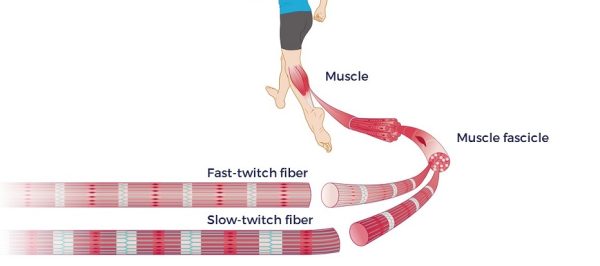
- Slow Twitch Muscle Fibers
Slow twitch muscle fibers are the first to respond to physical activity. They are designed to sustain low force over long durations.
Activities that recruit slow twitch muscle fibers: running, power walking, cycling, swimming, aerobic exercises. lightweight or bodyweight exercises with high repetitions.
- Fast Twitch Muscle Fibers
Some activities require maximum exertion, which your slow twitch muscle fibers can’t handle. When this happens, your fast twitch muscle fibers are recruited to take over for the slow twitch muscle fibers. Fast twitch muscle fibers get tired quicker than slow twitch and they require a period of rest.
Activities that recruit fast twitch muscle fibers: Power exercises, short sprints, weightlifting, crossfit
Slow twitch muscle fibers are the ones with endurance-boosting ability. When focusing on endurance training, you are training your slow twitch muscle fibers. Fast twitch muscle fibers are for short bursts of strength and power, while slow twitch is endurance
Recommended intensity, frequency, set and rep range for Muscular endurance.
- Intensity: lower than 67% of 1RM
- Set and Reps: 2-4 sets of 10-25 repetitions
- Between reps: Up to 30 seconds rest
- Between Sets: 30-60 seconds rest
- Frequency: 2-4 days per week
Sample: Muscular Endurance Training
1 Week
| Exercise | sets / reps | Rest |
| Push-up | 2 x 20 | 30 seconds |
| Bodyweight Squat | 2 x 25 | 30 seconds |
| Barbell Row | 2 x 12 1RM %40-50 | 30-45 second |
| Plank | 45 sec | 30 second |
2 Week
| Exercise | sets / reps | Rest |
| Push-up | 2 x 25 | 30 seconds |
| Bodyweight Squat | 2 x 30 | 30 seconds |
| Barbell Row | 2 x 15 1RM %40-50 | 30-45 second |
| Plank | 60 sec | 30 second |
3 Week
| Exercise | sets / reps | Rest |
| Push-up | 3 x 25 | 30 seconds |
| Bodyweight Squat | 3 x 30 | 30 seconds |
| Barbell Row | 3 x 15 1RM %50 | 30-45 second |
| Plank | 60 sec | 30 second |
4 Week
| Exercise | sets / reps | Rest |
| Push-up | 3 x 30 | 30 seconds |
| Bodyweight Squat | 3 x 35 | 30 seconds |
| Barbell Row | 3 x 20 1RM %50-60 | 30-45 second |
| Plank | 90 sec | 30 second |
3. Flexibility
First, a couple definitions: flexibility is the ability of a muscle to stretch and mobility is the ability of a joint to move freely through its range of motion. Both are important parts of overall fitness, and both should be incorporated into your fitness routine.
WARMING UP AND STRETCHING Warm-up helps prepare your body for aerobic activity. Because the main purpose of warming is to prepare your whole body for training. With a proper warm up exercise and stretching routine the elasticity and flexibility of the tendons and ligaments are increased. Warm-up and stretching is an activity that does not take much time, even a 5-10 minute warming routine will help you avoid injury.
Dynamic stretching consists of active movements. It is usually done before a workout to help warm up your muscles and increase your heart rate. Move slowly, stop and repeat, dig a little deeper each time and improve your range of motion. Pre-workout dynamic stretching improves circulation, prepares your muscles for movement, and temporarily increases your range of motion.
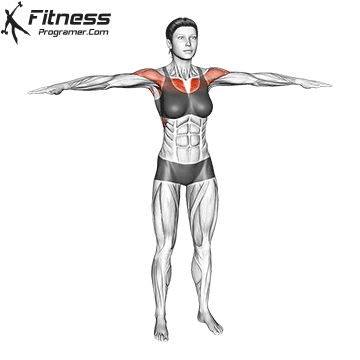
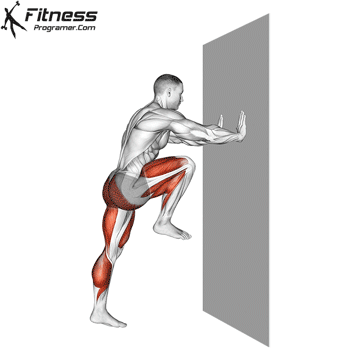
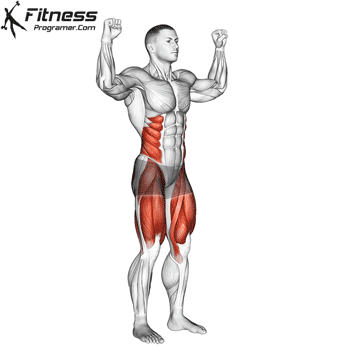
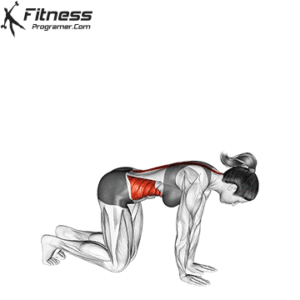
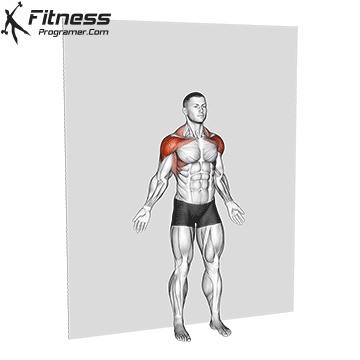
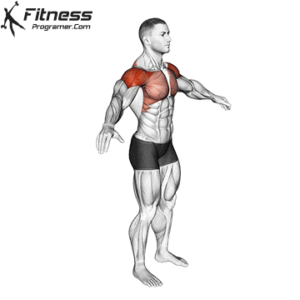
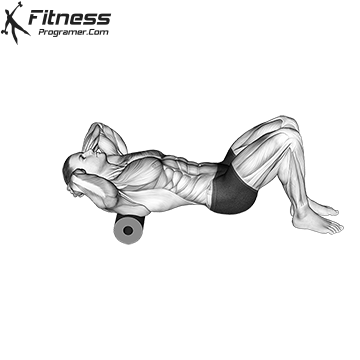
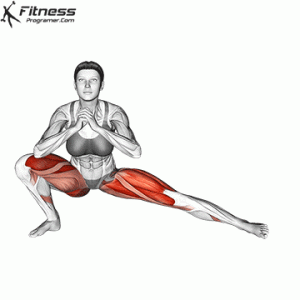
Static stretching, more commonly done at the end of a workout when your muscles are warm, is when stretches are held in place for a certain period of time, not moving. Static stretching is the most effective form of stretching for loosening up your muscles, joints, ligaments, and tendons, while also improving flexibility and range of motion. Static stretching requires you to move a muscle to the end of its range of motion and maintain this position for 20 to 45 seconds. Repeat this 2 to 3 times each.
- Each time you perform aerobic or strength-training activities, take an extra 10 minutes to stretch the major muscle groups.
- Hold stretches for at least 10 to 30 seconds and repeat each stretch 2 to 3 times
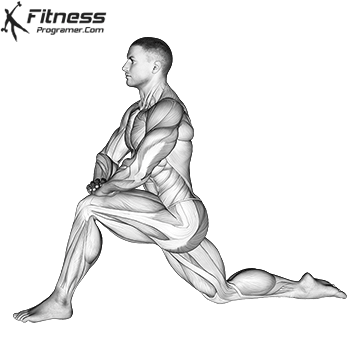
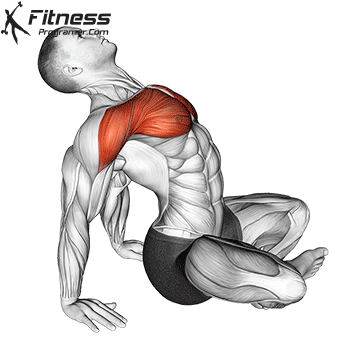
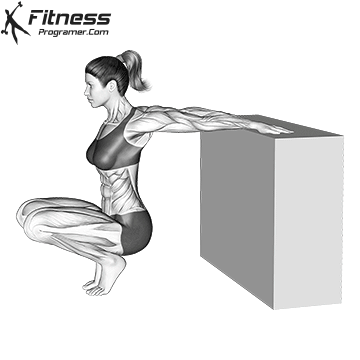
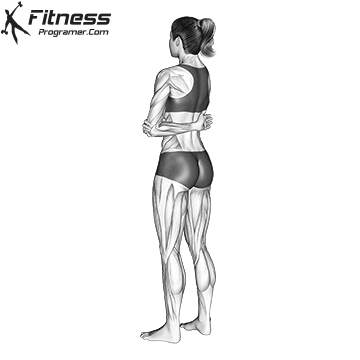
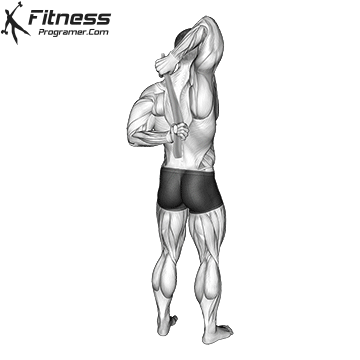
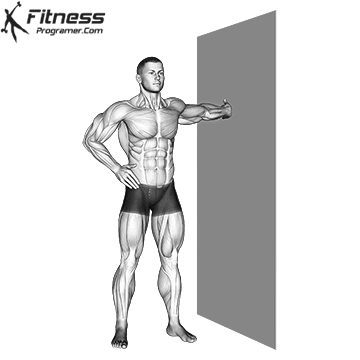
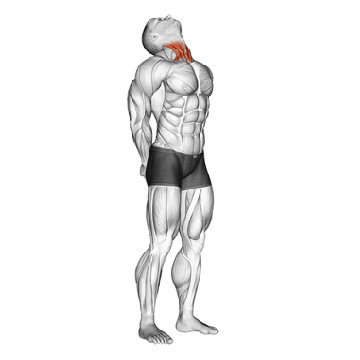
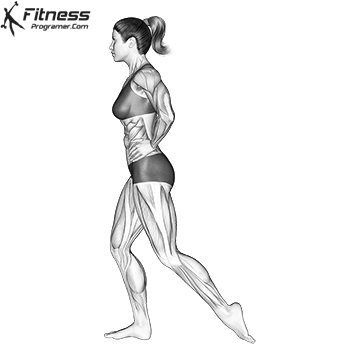

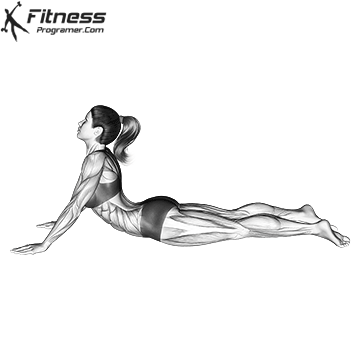
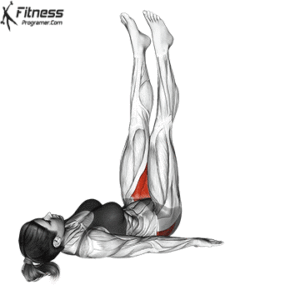
Frequently Asked Questions for Fitness
How much weight should I lift to gain muscle?
For beginners, 1 to 3 sets of 6 to 12 repetitions per exercise with a moderate load (60% to 85% of one-rep max) is ideal. More advanced individuals looking to further develop muscle mass can perform 3 to 6 sets of 8 to 12 repetitions at 70% to 85% of one-rep max.
HOW MANY SETS AND REPS SHOULD I DO?
Different training organizations, such as the American Council on Exercise (ACE) or the National Academy of Sports Medicine (NASM), have slightly different models for each training goal. But they follow the same general guidelines.
| Training Goal | Sets | Reps | Rest Period | Intensity / Weight |
| General fitness | 1-3 | 12-15 | 30 to 90 seconds | Varies |
| Endurance | 2-4 | 12-20 | Up to 30 seconds | <67% of 1RM |
| Hypertrophy | 3-6 | 6-12 | 30 to 90 seconds | 67% to 85% of 1RM |
| Muscle strength | 2-6 | <6 | 2 to 5 minutes | >85% of 1RM |
| Power: Single rep | 3-5 | 1-2 | 2 to 5 minutes | 80%–90% of 1RM |
| Muscle Power | 3-6 | 1-3 | 2 to 5 minutes | 30%–60% of RM |
What is PROGRESSIVE OVERLOAD
What is Progressive Overload; It is a working principle that involves gradually increasing the weight of your exercise over time so that you can continuously gain muscle, strength and endurance. It’s the gradual increase in strength by adding small weight plates every training session.
When you do intense weight training, your muscle fibers are subject to injury or stress. When your muscles are damaged in this way, satellite cells outside the muscle fibers come into play. The repair process involves rejoining the torn muscle fibers and introducing new proteins into each muscle cell. They try to repair the damage by bringing them together, as a result, they grow and strengthen the muscle fiber against this weight resistance.
Nutrition for Fitness
The training methods given here are only part of achieving your fitness goals. The truth is, nutrition is the most important part of this business, and the links below will guide you to learn how to manage calories.
Not: The purpose of this article is to provide information about fitness and more advanced training methods, sample training plans are just for you to get an idea of, and it does not promise definitive results to anyone. Each person’s body structure, metabolism, lifestyle and goals are different, it is recommended to consult a personal trainer for best results.
Source:
- https://pubmed.ncbi.nlm.nih.gov/27102172/
- https://www.ncbi.nlm.nih.gov/pmc/articles/PMC7447706/
- https://www.researchgate.net/publication/49282510_Methods_to_Increase_the_Effectiveness_of_Maximal_Power_Training_for_the_Upper_Body
- https://www.researchgate.net/publication/323572824_Resistance_Training_Methods_to_Develop_Maximum_Strength_Power_and_Hypertrophy
- https://www.researchgate.net/publication/235653976_Progression_models_in_resistance_training_for_healthy_adults_ACSM_position_stand
- https://www.semanticscholar.org/paper/Manipulating-Resistance-Training-Program-Variables-Tan/930ab121b1b46776ffde3858979c747bd8f8ae93

